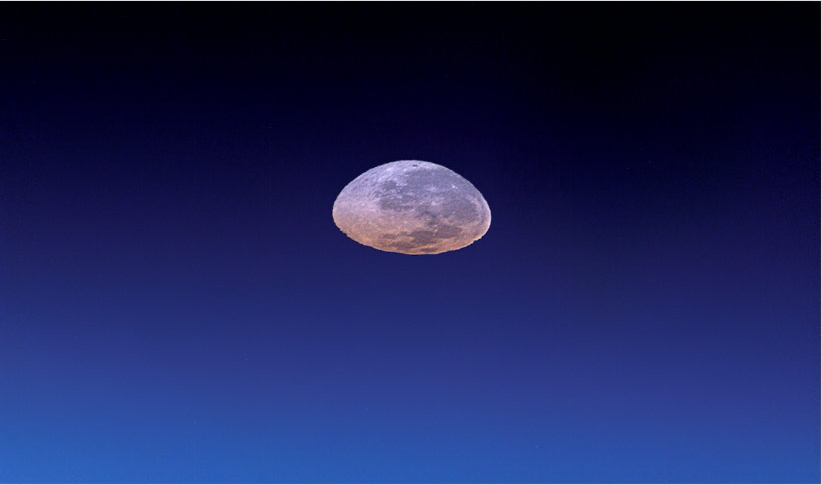Moonset from Earth Orbit II
Moonset from Earth Orbit II: A Spectacular View of the Full Moon
In the vast expanse of Earth's blue atmosphere, an extraordinary sight unfolds. It is the moon, in all its fullness, gracefully descending towards the horizon. This captivating phenomenon, known as "Moonset from Earth Orbit II," offers a unique perspective of our celestial companion from the International Space Station (ISS). Despite the immense distortion caused by differential refraction, the surface features of the moon remain discernible, allowing us to marvel at its intricate details.
As we gaze at this remarkable image captured by Don Pettit from the ISS, we can appreciate the intricate interplay between light and atmosphere. Differential refraction, the phenomenon responsible for the distortion of the moon's appearance, occurs when light passes through layers of varying density in the Earth's atmosphere. This bending of light alters the path it takes, causing objects to appear distorted or displaced. In the case of the moon, its surface features undergo significant changes as it nears the horizon.
Near the lower limb of the moon, we observe a striking flattening of the Mare Crisium, one of its prominent features. This flattened appearance is a direct result of the differential refraction mentioned earlier. The layers of Earth's atmosphere refract light differently at various altitudes, creating a distorted view of the moon's surface. Conversely, towards the top of the moon, we can still discern the Mare Imbrium, which retains a semblance of its normal appearance. The interplay between these two contrasting regions adds to the captivating allure of Moonset from Earth Orbit II.
The image captured by Don Pettit serves as a testament to the ingenuity and technological prowess that allows astronauts aboard the ISS to capture such breathtaking views. The International Space Station, orbiting approximately 408 kilometers above Earth's surface, provides an unparalleled vantage point from which to observe and document atmospheric phenomena. It serves as a platform for scientific research, technological advancements, and offers astronauts a unique perspective of our planet and the cosmos beyond.
Moonset from Earth Orbit II exemplifies the awe-inspiring beauty and complexity of atmospheric optics. It reminds us of the intricate dance between light, atmosphere, and celestial bodies that takes place every day, often unnoticed from our terrestrial vantage point. This phenomenon serves as a captivating reminder of the wonders that await us when we venture beyond the boundaries of our home planet.
In conclusion, Moonset from Earth Orbit II offers a mesmerizing view of the full moon as it gracefully descends towards the Earth's horizon. Through the lens of differential refraction, we witness the distortion and flattening of lunar surface features, such as the Mare Crisium, while other regions, like the Mare Imbrium, retain their familiar appearance. This captivating image serves as a testament to the incredible perspective afforded by the International Space Station and the intricate interplay between light and atmosphere. It is a reminder of the beauty and complexity that lie beyond our earthly confines, waiting to be explored and understood.

An impossible full moon floats in Earths blue atmosphere. In this view of the full moon as seen setting from the ISS, the surface features remain distinguishable in spite of the massive distortion by differential refraction. Near the lower limb the Mare Crisium is highly flattened whereas at top the Mare Imbrium has a semblance of its normal appearance. From Don Pettit's frame ISS-006-E-45773 courtesy NASA.
Note: this article has been automatically converted from the old site and may not appear as intended. You can find the original article here.
Reference Atmospheric Optics
If you use any of the definitions, information, or data presented on Atmospheric Optics, please copy the link or reference below to properly credit us as the reference source. Thank you!
-
<a href="https://atoptics.co.uk/blog/moonset-from-earth-orbit-ii/">Moonset from Earth Orbit II</a>
-
"Moonset from Earth Orbit II". Atmospheric Optics. Accessed on November 26, 2024. https://atoptics.co.uk/blog/moonset-from-earth-orbit-ii/.
-
"Moonset from Earth Orbit II". Atmospheric Optics, https://atoptics.co.uk/blog/moonset-from-earth-orbit-ii/. Accessed 26 November, 2024
-
Moonset from Earth Orbit II. Atmospheric Optics. Retrieved from https://atoptics.co.uk/blog/moonset-from-earth-orbit-ii/.